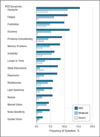Predicting postconcussion syndrome after mild traumatic brain injury in children and adolescents who present to the emergency department
- PMID: 23247384
- PMCID: PMC4461429
- DOI: 10.1001/jamapediatrics.2013.434
Predicting postconcussion syndrome after mild traumatic brain injury in children and adolescents who present to the emergency department
Abstract
Objective: To determine the acute predictors associated with the development of postconcussion syndrome (PCS) in children and adolescents after mild traumatic brain injury.
Design: Retrospective analysis of a prospective observational study.
Setting: Pediatric emergency department (ED) in a children's hospital.
Participants: Four hundred six children and adolescents aged 5 to 18 years.
Main exposure: Closed head trauma.
Main outcome measures: The Rivermead Post Concussion Symptoms Questionnaire administered 3 months after the injury.
Results: Of the patients presenting to the ED with mild traumatic brain injury, 29.3% developed PCS. The most frequent PCS symptom was headache. Predictors of PCS, while controlling for other factors, were being of adolescent age, headache on presentation to the ED, and admission to the hospital. Patients who developed PCS missed a mean (SD) of 7.4 (13.9) days of school.
Conclusions: Adolescents who have headache on ED presentation and require hospital admission at the ED encounter are at elevated risk for PCS after mild traumatic brain injury. Interventions to identify this population and begin early treatment may improve outcomes and reduce the burden of disease.
Conflict of interest statement
Figures
Comment in
-
Postconcussion syndrome after mild traumatic brain injury in children and adolescents requires further detailed study.JAMA Neurol. 2013 May;70(5):636-7. doi: 10.1001/jamaneurol.2013.2801. JAMA Neurol. 2013. PMID: 23529540 No abstract available.
Similar articles
-
A Novel Tool for Evaluation of Mild Traumatic Brain Injury Patients in the Emergency Department: Does Robotic Assessment of Neuromotor Performance Following Injury Predict the Presence of Postconcussion Symptoms at Follow-up?Acad Emerg Med. 2016 Apr;23(4):382-92. doi: 10.1111/acem.12906. Epub 2016 Mar 21. Acad Emerg Med. 2016. PMID: 26806406 Free PMC article.
-
Inability of S100B to predict postconcussion syndrome in children who present to the emergency department with mild traumatic brain injury: a brief report.Pediatr Emerg Care. 2013 Apr;29(4):458-61. doi: 10.1097/PEC.0b013e31828a202d. Pediatr Emerg Care. 2013. PMID: 23528506 Free PMC article.
-
Missed Emergency Department Diagnosis of Mild Traumatic Brain Injury in Patients with Chronic Pain After Motor Vehicle Collision.Pain Physician. 2023 Jan;26(1):101-110. Pain Physician. 2023. PMID: 36791299
-
Postconcussion syndrome (PCS) in the emergency department: predicting and pre-empting persistent symptoms following a mild traumatic brain injury.Emerg Med J. 2014 Jan;31(1):72-7. doi: 10.1136/emermed-2012-201667. Epub 2013 Mar 6. Emerg Med J. 2014. PMID: 23468281 Review.
-
[Mild traumatic brain injury and postconcussive syndrome: a re-emergent questioning].Encephale. 2012 Sep;38(4):329-35. doi: 10.1016/j.encep.2011.07.003. Epub 2011 Aug 31. Encephale. 2012. PMID: 22980474 Review. French.
Cited by
-
Expert consensus document: Mind the gaps—advancing research into short-term and long-term neuropsychological outcomes of youth sports-related concussions.Nat Rev Neurol. 2015 Apr;11(4):230-44. doi: 10.1038/nrneurol.2015.30. Epub 2015 Mar 17. Nat Rev Neurol. 2015. PMID: 25776822 Review.
-
No Evidence of a Difference in Susceptibility-Weighted Imaging Lesion Burden or Functional Network Connectivity between Children with Typical and Delayed Recovery Two Weeks Post-Concussion.J Neurotrauma. 2021 Sep 1;38(17):2384-2390. doi: 10.1089/neu.2021.0069. Epub 2021 Jul 30. J Neurotrauma. 2021. PMID: 33823646 Free PMC article.
-
Academic outcomes and accommodations following adolescent sport-related concussion: a pilot study.Concussion. 2017 Oct 23;2(4):CNC51. doi: 10.2217/cnc-2017-0009. eCollection 2017 Dec. Concussion. 2017. PMID: 30202592 Free PMC article.
-
Age of First Concussion and Cognitive, Psychological, and Physical Outcomes in NCAA Collegiate Student Athletes.Sports Med. 2022 Nov;52(11):2759-2773. doi: 10.1007/s40279-022-01719-7. Epub 2022 Jul 6. Sports Med. 2022. PMID: 35794432 Free PMC article.
-
Altered functional connectivity in children with mild to moderate TBI relates to motor control.J Pediatr Rehabil Med. 2015;8(4):309-19. doi: 10.3233/PRM-150349. J Pediatr Rehabil Med. 2015. PMID: 26684071 Free PMC article.
References
-
- Jager TE, Weiss HB, Coben JH, Pepe PE. Traumatic brain injuries evaluated in US emergency departments, 1992–1994. Acad Emerg Med. 2000;7(2):134–140. - PubMed
-
- Committee on Quality Improvement American Academy of Pediatrics. Commission on Clinical Policies and Research American Academy of Family Physicians. The management of minor closed head injury in children. Pediatrics. 1999;104(6):1407–1415. - PubMed
-
- Ewing-Cobbs L, Fletcher JM, Levin HS, Francis DJ, Davidson K, Miner ME. Longitudinal neuropsychological outcome in infants and preschoolers with traumatic brain injury. J Int Neuropsychol Soc. 1997;3(6):581–591. - PubMed
-
- Fay GC, Jaffe KM, Polissar NL, et al. Mild pediatric traumatic brain injury: a cohort study. Arch Phys Med Rehabil. 1993;74(9):895–901. - PubMed
Publication types
MeSH terms
Grants and funding
LinkOut - more resources
Full Text Sources
Other Literature Sources


